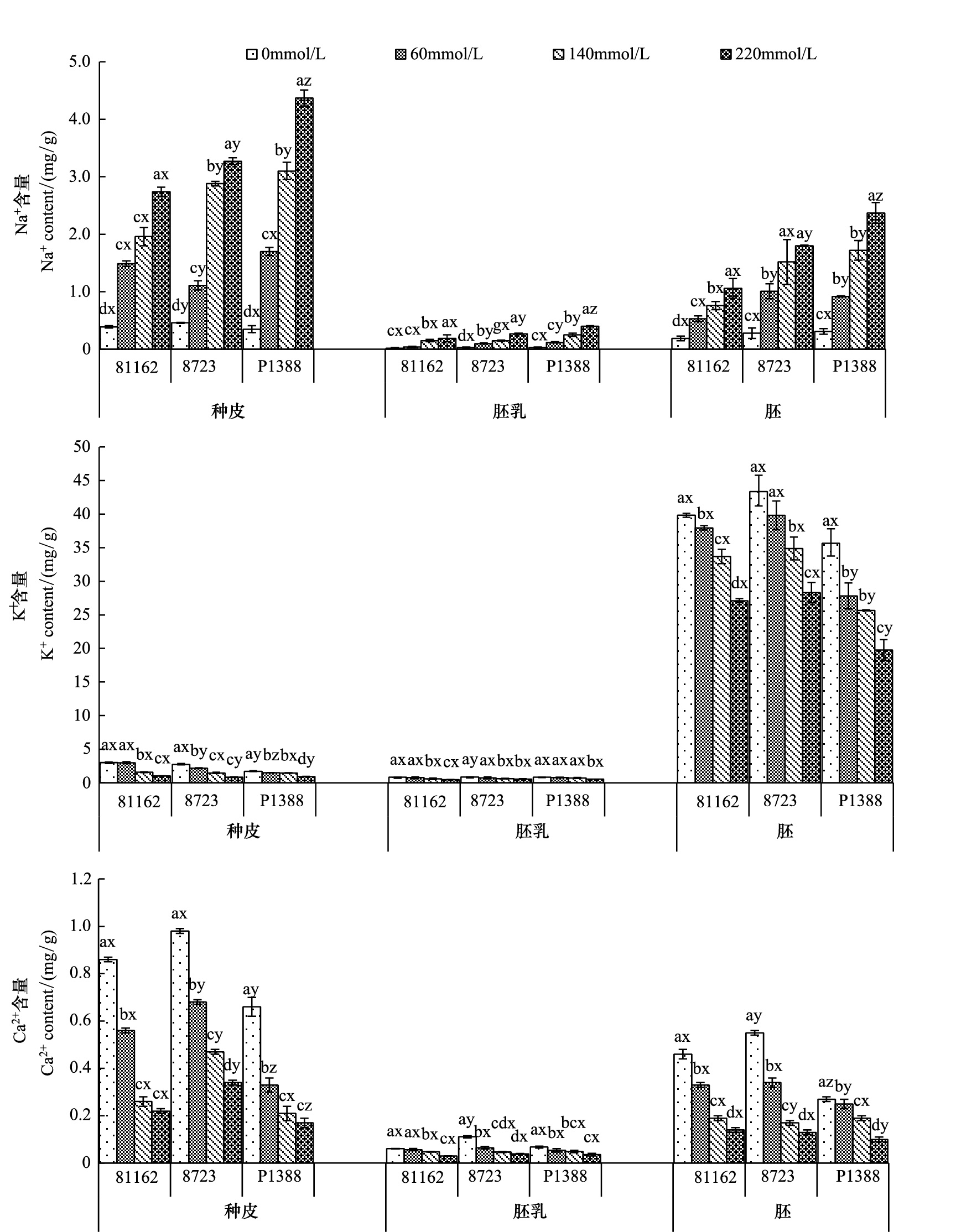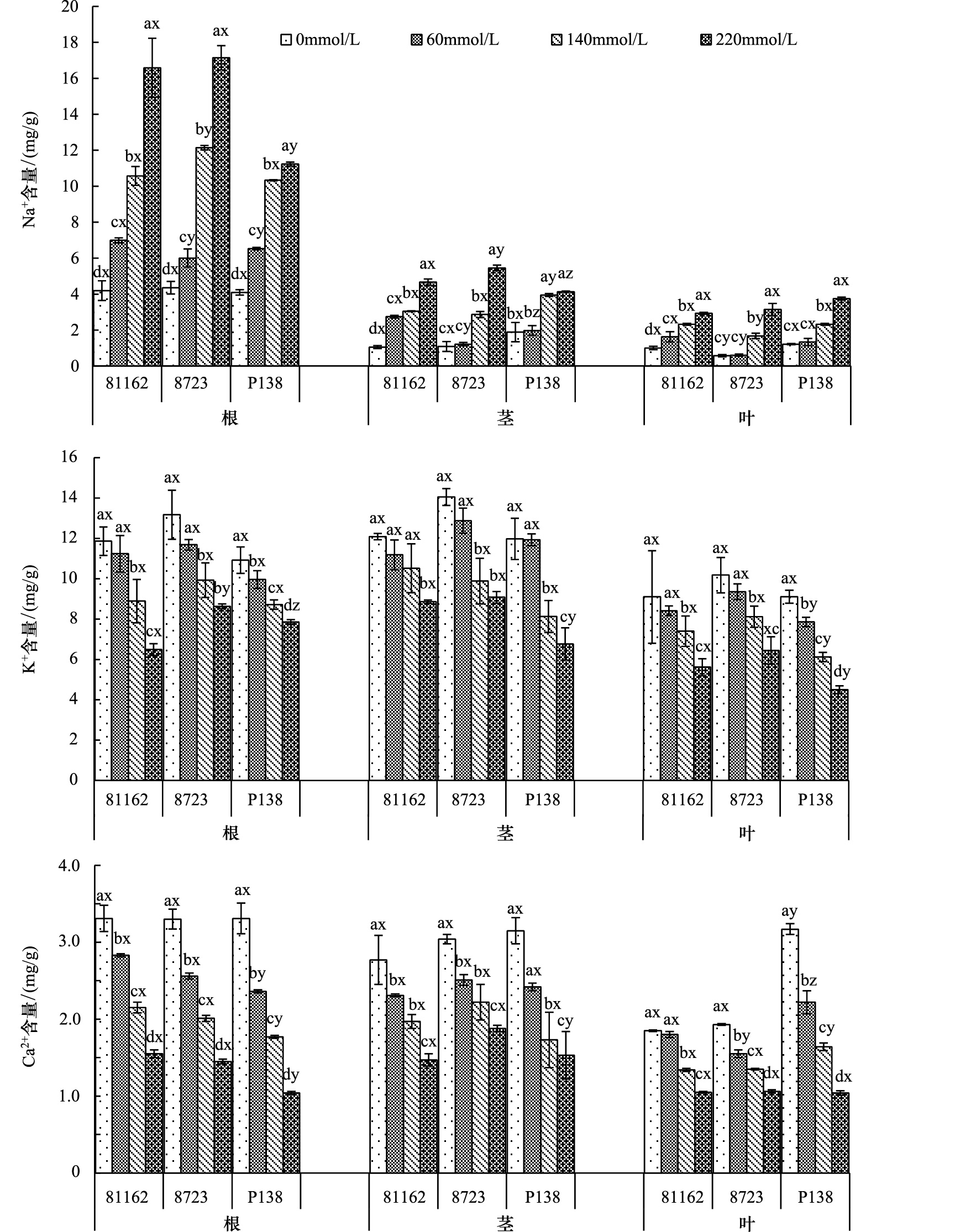文章信息
- 彭云玲, 保杰, 叶龙山, 王永健, 燕利斌
- PENG Yunling, BAO Jie, YE Longshan, WANG Yongjian, YAN Libin
- NaCl胁迫对不同耐盐性玉米自交系萌动种子和幼苗离子稳态的影响
- Ion homeostasis in germinating seeds and seedlings of three maize inbred lines under salt stress
- 生态学报, 2014, 34(24): 7320-7328
- Acta Ecologica Sinica, 2014, 34(24): 7320-7328
- http://dx.doi.org/10.5846/stxb201303150431
-
文章历史
- 收稿日期:2013-03-15
- 网络出版日期:2014-03-19
在我国0.67亿hm2 耕地中有10%为盐渍化土壤,土壤盐渍化已成为限制农作物产量进一步提高的重要环境因子之一[1]。玉米(Zea mays)对盐分中度敏感,耐盐性相对较差[2]。因此,深入研究玉米耐盐生理机制,筛选耐盐品种,培育具有一定耐盐能力的玉米,对充分利用盐渍化土地,提高玉米产量具有重要意义。
盐胁迫对玉米的主要伤害是盐离子在细胞内大量累积,导致离子毒害和离子不平衡,特别是Na+。盐胁迫下Na+大量涌入胞内,不仅破坏细胞中已形成的离子平衡状态,而且影响K+和Ca2+的胞内含量和分布[3, 4]。Na+对细胞K+的吸收呈现明显竞争性抑制[5];同时高浓度Na+可置换质膜和细胞内膜系统所结合的Ca2+,膜系统完整性被破坏,膜透性增大,细胞物质交换平衡被破坏,导致生理生化代谢紊乱。盐胁迫下细胞内离子平衡破坏的一个典型指标就是K+/Na+降低[6]。
种子萌发与早期幼苗生长阶段是决定植物能否在盐渍环境下生长最关键的时期[7, 8]。国内外学者对盐胁迫下作物幼苗离子含量进行了大量研究[9, 10, 11, 12, 13],初步探索出了盐胁迫下作物离子含量的变化规律,但是以不同耐盐品种萌动种子和幼苗为材料共同研究玉米耐盐机理报道较少[14]。为此,本试验以前期筛选出的耐盐玉米自交系8723、81162和盐敏感自交系P138为材料,在不同浓度NaCl溶液处理下,研究不同玉米品种Na+、K+、Ca2+在萌动种子和幼苗中各部分的分布及变化,旨在为玉米耐盐性评价体系的建立和耐盐育种提供理论依据。
1 材料与方法 1.1 材料耐盐自交系8723、81162和盐敏感自交系P138[15]。其中8723来源于引进玉米自交系8723,81162来源于525×掖107后代材料,P138来源于美国杂交种P78599的后代材料。
1.2 胁迫处理种子萌发期胁迫处理:精选无破损、大小一致的种子,用0.5%的次氯酸钠消毒10 min,蒸馏水冲洗3—5次,用滤纸吸干附着水,置于直径为12 cm的培养皿中,双层滤纸作发芽床,每皿30粒。分别加入浓度为0、60、140、220mmol/L的NaCl溶液,3次重复。置于培养箱中25℃暗萌发。
幼苗生长期胁迫处理:用15 cm×13 cm的营养钵进行幼苗培养,并设置0、60、140、 220 mmol/L的NaC1溶液进行处理,每处理设3次重复。100 mL各对应浓度的NaC1溶液与500 g已灭菌的蛭石搅拌均匀后分装于营养钵中。播种前种子用0.5%的次氯酸钠消毒10 min,蒸馏水冲洗3—5次,然后将种子分别浸泡在0、60、140、220 mmol/L的NaC1溶液中,浸泡12 h后,直接播在含有相同盐浓度的消毒蛭石中,每钵10粒。播种后于植物生长室中培养,生长室的昼/夜温度为(25±2)/(20±2)℃,每天光照12 h,光照强度为600 μmol s-1 m-2,相对湿度60%—80%,定时定量浇水。幼苗在加有不同浓度盐溶液的蛭石中生长10 d,对照叶片生长到三叶一心时,进行各项生长指标的测定。
1.3 离子含量测定将耐盐自交系8723、81162和盐敏感自交系P138分别在萌发期和幼苗生长期进行胁迫处理。萌发期胁迫处理的种子,待种子萌动后用60 mmol/L的NaCl溶液冲洗干净,将种皮、胚、胚乳分离;幼苗生长期胁迫处理的种子,待幼苗长到三叶一心时,用60 mmol/L NaCl溶液冲洗干净,将根、茎、叶分离,置105℃烘箱中10 min,然后于80℃下烘48h。用等离子质谱测定Na+、K+、Ca2+离子的含量。
1.4 数据统计与分析所有试验数据使用统计软件SPSS16.0进行处理,试验结果用平均值±标准偏差(SD)表示,采用Duncan进行差异显著性多重比较,对各处理间的差异显著性进行分析。
2 结果与分析 2.1 萌动种子中Na+、K+、Ca2+含量的变化如图 1所示,萌动种子中,3个自交系中不同部位的Na+含量顺序是种皮>胚>胚乳;K+含量顺序是胚>种皮>胚乳;Ca2+含量顺序是种皮>胚>胚乳。萌动种子中Na+含量随NaCl浓度的增加而增加,3个自交系表现相同的上升趋势。与对照相比,60、140、220 mmol/L NaCl处理后,81162 Na+含量分别上升2.82、4.02、6.03倍;8723分别上升1.88、4.91、5.94倍;P138分别上升2.97、6.35、9.34倍。由此可见,萌发期耐盐自交系81162和8723的Na+积累速度小于盐敏感自交系P138。耐盐自交系81162和8723中Na+含量小于盐敏感自交系P138。随着NaCl浓度的增加,3个自交系萌动种子中K+和Ca2+含量均呈下降趋势。与对照相比,220 mmol/L NaCl处理后,81162的Ca2+含量分别下降71.76%;8723分别下降68.98%;P138分别下降69.34%。81162的K+含量下降34.46%,8723下降36.84%,P138下降44.31%。由此可见,萌动种子中K+和Ca2+的流失都比较多,尤其是Ca2+。但是3个自交系中Ca2+的流失差异不大;而K+离子在盐敏感自交系P138中的降低幅度大于耐盐自交系81162和8723。除了胚乳中,K+和Ca2+含量在耐盐自交系81162和8723及盐敏感自交系P138之间没有差异外,在胚和种皮中,K+和Ca2+的积累量几乎在每个浓度下耐盐自交系81162和8723都大于盐敏感自交系P138。

|
| 图 1 盐胁迫下不同玉米品种在萌动种子中Na+、K+、Ca2+含量的变化 Fig. 1 Changes of Na+、Ca2+ and K+ content in germinating seeds of three maize inbred lines under different NaCl concentrations 不同小写字母abcd表示不同盐浓度下0.05水平差异显著,xyz表示品种间0.05水平差异显著 |
如图 2所示,在幼苗中,3个玉米自交系Na+含量的顺序是根>茎>叶;根和茎中的Na+含量较高,而叶中含量较低。玉米幼苗中Na+含量随NaCl浓度的增加而增加,3个自交系表现相同的上升趋势。与对照相比,60、140、220mmol/L NaCl处理后,81162的Na+含量上升倍数分别为0.56、1.19、2.33;8723分别上升0.30、1.77、3.27;P138分别上升0.37、1.30、1.65。由此可见,幼苗生长期耐盐自交系81162和8723体内Na+积累大于盐敏感自交系P138,说明耐盐自交系81162和8723的耐Na+能力较强,而盐敏感自交系P138的耐Na+能力弱。另外,根和茎中耐盐自交系81162和8723中Na+含量大于盐敏感品种P138,而叶中盐敏感自交系P138中的Na+含量大于耐盐自交系81162和8723。

|
| 图 2 盐胁迫下不同玉米品种在幼苗中Na+、K+、Ca2+含量的变化 Fig. 2 Changes of Na+、Ca2+ and K+ content in young seedlings of three maize inbred lines under different NaCl concentrations |
如图 2所示,随着NaCl浓度的增加,3个玉米自交系幼苗中K+含量呈下降趋势。与对照相比,60、140、220 mmol/L NaCl处理后,81162的K+含量分别下降6.71%、18.58%、36.55%;8723分别下降9.33%、25.35%、35.40%;P138分别下降7.06%、28.21%、40.27%。由此可见,耐盐自交系81162和8723幼苗体内的K+含量下降幅度小于盐敏感自交系P138,同时耐盐自交系81162和8723中K+含量大于盐敏感自交系P138。
不同玉米自交系根茎叶中K+含量下降的幅度也不同。当NaCl浓度增至220mmol/L时,根中K+ 含量下降幅度81162为45.28%,8723为34.47%,P138为28.11%;茎K+含量下降幅度81162为26.72%,8723为35.37%,P138为43.48%;叶中K+含量下降幅度81162为38.24%,8723为36.64%,P138为50.60%。由此可以看出,高盐胁迫下耐盐自交系81162和8723根中K+含量的降低幅度大于盐敏感自交系P138,而茎和叶中K+含量的降低幅度小于盐敏感自交系P138。
2.2.3 不同浓度NaCl胁迫下玉米幼苗Ca2+含量的变化如图 2所示,随着NaCl浓度的增加,3个玉米自交系幼苗中Ca2+含量呈下降趋势。与对照相比,60、140、220 mmol/L NaCl处理后,81162的Ca2+含量分别下降12.48%、31.15%、48.68%;8723分别下降19.95%、32.53%、46.92%;P138分别下降27.21%、46.63%、62.51%。由此可见,耐盐自交系81162和8723幼苗体内Ca2+含量下降幅度小于盐敏感品种P138;同时耐盐自交系81162和8723根茎中Ca2+含量大于盐敏感自交系P138,但是叶片中则小于敏感自交系P138。
不同自交系根茎叶中Ca2+含量下降的幅度也不同。当NaCl浓度达到220mmol/L时,根中Ca2+含量的下降幅度81162为53.17%,8723为56.06%,P138为68.58%,茎中Ca2+含量的下降幅度81162为46.93%,8723为38.15%,P138为51.43%,叶片中Ca2+含量的下降幅度81162为43.24%,8723为45.08%,P138为67.19%。由此可见,耐盐自交系根茎叶中Ca2+含量降低幅度小于盐敏感自交系,因此能更好地维持各种代谢,保证玉米的正常发育。
2.3 萌动种子及幼苗中Na+、K+、Ca2+比值的变化如表 1和表 2所示,萌动种子和玉米幼苗各部位K+/Na+和Ca2+/Na+均随着NaCl浓度的升高而降低,与对照相比存在显著性差异。耐盐自交系81162和8723不管在萌动种子还是在幼苗中的K+/Na+都高于盐敏感自交系P138,表明耐盐自交系通过渗透调节保持较高的K+/Na+比值,从而增强耐盐性。总体来看,萌动种子种胚中的K+/Na+高于种皮;幼苗中地上部分的K+/Na+和Ca2+/Na+高于地下部分,表明盐胁迫下种胚和地上部分能通过调节离子平衡维持相对较高的Ca2+/Na+和K+/Na+值,尽量保证光合器官和幼嫩组织少受盐害。
| 种子部位Part of seeds | NaCl浓度/(mmol/L)NaClconcentration | K+/Na+ | Ca2+/Na+ | ||||
| 81162 | 8723 | P138 | 81162 | 8723 | P138 | ||
| 种皮Testa | 0 | 7.79ax | 5.96ay | 4.89az | 2.21ax | 2.13ax | 1.89ay |
| 60 | 2.02bx | 1.96by | 0.89bz | 0.38bx | 0.61by | 0.19bz | |
| 140 | 0.82cx | 0.52cy | 0.47cz | 0.13cx | 0.16cx | 0.07cy | |
| 220 | 0.38dx | 0.26dy | 0.22dz | 0.08dx | 0.10dy | 0.04dz | |
| 胚乳Endosperm | 0 | 42.00ax | 30.00ay | 28.00az | 3.05ax | 3.70ax | 2.27ay |
| 60 | 19.5bx | 7.50by | 6.67bz | 1.43bx | 0.64by | 0.45bz | |
| 140 | 4.07cx | 4.33cx | 2.92cy | 0.32cx | 0.31cx | 0.20cy | |
| 220 | 2.58dx | 2.15dx | 1.43dy | 0.16dx | 0.14dx | 0.09dy | |
| 胚Embryo | 0 | 209.68ax | 155.21ay | 115.03az | 2.42ax | 1.96ay | 0.87az |
| 60 | 71.62bx | 39.42by | 30.23bz | 0.62bx | 0.33by | 0.27bz | |
| 140 | 44.33cx | 22.94cy | 14.93cz | 0.25cx | 0.11cy | 0.11cy | |
| 220 | 25.58dx | 15.72dy | 8.34dz | 0.13dx | 0.07dy | 0.04dz | |
| 幼苗部位Part of seedling | NaCl浓度/(mmol/L)NaClconcentration | K+/Na+ | Ca2+/Na+ | ||||
| 81162 | 8723 | P138 | 81162 | 8723 | P138 | ||
| 根Root | 0 | 2.82ax | 3.02ay | 2.66ax | 0.79ax | 0.76ax | 0.81ax |
| 60 | 1.61bx | 1.94by | 1.53bx | 0.40bx | 0.43bx | 0.36bx | |
| 140 | 0.84cx | 0.82cx | 0.84cx | 0.20cx | 0.17cx | 0.17cx | |
| 220 | 0.39dx | 0.56dy | 0.70dz | 0.09dx | 0.08dx | 0.09dx | |
| 茎Root crown | 0 | 5.87ax | 12.89ay | 6.34ax | 1.34ax | 2.79ay | 1.67ax |
| 60 | 4.07bx | 10.56by | 6.03bz | 0.84bx | 2.06by | 1.22bz | |
| 140 | 3.45cx | 3.44cx | 2.06cy | 0.65cx | 0.77cx | 0.44cy | |
| 220 | 1.90dx | 1.66dy | 1.64dy | 0.31dx | 0.34dx | 0.37dx | |
| 叶Leaf | 0 | 9.00ax | 17.55ay | 7.47az | 1.83ax | 3.33ay | 2.6az |
| 60 | 5.16bx | 15.33by | 5.87bx | 1.10bx | 2.54by | 1.66bz | |
| 140 | 3.18cx | 4.83cy | 2.63cz | 0.58cx | 0.80cy | 0.70cy | |
| 220 | 1.91dx | 2.05dy | 1.20dz | 0.36dx | 0.34dx | 0.28dy | |
正常情况下,玉米细胞内各种离子的含量处于相对平衡状态,从而维持正常的生理活动。植物受到盐胁迫时,细胞内离子平衡受破坏,生理功能紊乱。由于Na+和K+有相似的离子半径和水合能,两者之间会相互竞争转运体的同一结合位,Na+往往利用K+的途径进入植物体内,Na+的含量显著增加,Na+对K+的吸收呈明显竞争性抑制[5, 14, 16, 17],这一点在3个玉米自交系萌动种子和幼苗中得到了体现,随着NaCl浓度的增加,Na+含量增加,而K+含量降低。即玉米自交系对K+的吸收明显受盐胁迫浓度的影响,随盐胁迫浓度的增大,其对K+的吸收就减弱,这是环境中高Na+含量抑制了植物对K+的吸收,是Na+对K+的拮抗作用造成的[17, 18],也就是说当外界环境存在大量Na+的盐胁迫时,质膜透性增强,质膜对K+的选择性降低。Ca2+作为植物生长发育所需的重要营养元素,对于维持盐胁迫植物正常生长具有十分重要的意义。已有研究表明,液泡膜上存在2种Ca2+通道,当植物受到盐胁迫时,Ca2+通道受诱导开放从液泡中释放出来,与钙调蛋白或钙结合蛋白结合,调节细胞代谢或基因表达,促进植物适应逆境[19]。在盐胁迫下,细胞质膜上Ca2+可能被Na+所取代,降低了细胞膜的选择性和稳定性,从而导致Na+离子的大量进入和营养物质的外泄。
萌动种子,3个自交系种皮中Na+含量高于种胚,表明种子在高盐环境中将Na+运输到种皮中保护种胚使其免受离子毒害,确保在种子萌发期间的正常发育,推测这是种子萌发期抵御逆境的机制。这与Song等[13]报道的结果相一致。胚中的K+含量高于种皮,表明胚选择性吸收K+而排斥Na+,利用较高浓度的K+浓度进行渗透调节,以提高其抗盐性,避免使种胚受到伤害。玉米幼苗中根中的Na+含量高于茎中的Na+含量,茎中的Na+含量高于叶中的Na+含量,可见玉米幼苗主要将Na+储存在根部,阻止其往上运输,减少对地上部分的伤害。这与钟小仙等[20]、商学芳等[14]、王丽燕和赵可夫[21]报道的结果一致。
萌动种子中81162和8723中的Na+增加幅度和含量小于P138,表明耐盐自交系81162和8723的拒Na+能力较强,而盐敏感自交系P138的拒Na+能力较弱,从而在体内聚集了过多的Na+;尤其是盐敏感自交系P138体内有过多的Na+流向胚部,从而造成对胚的伤害,影响了种子的萌发。胚和种皮中,耐盐自交系81162和8723中K+离子的降低幅度小于盐敏感自交系P138,表明耐盐自交系能通过选择性的吸收K+,而排斥Na+,利用较高的K+浓度,维持较高的K+/Na+来进行渗透调节,以提高其抗盐性。这一结果与萌动种子中耐盐自交系81162和8723相对盐敏感自交系P138有较高的K+/Na+的结果相一致,因而有较高的耐盐性。Zhu[22]指出K+/Na+的高低作为许多植物较为可靠的耐盐指标,本研究结果进一步印证了这一结论;同时也充分说明了耐盐自交系81162和8723将更多的K+积累在胚部,从而使胚的K+/Na+值升高,从而提高了萌发期的耐盐性。
耐盐自交系81162和8723根和茎中的Na+含量大于盐敏感自交系P138,而在叶中则小于盐敏感自交系P138。说明耐盐自交系81162和8723能够将吸收的Na+较多地积累在根茎部,阻止其向上运输,从而使其叶片中的Na+含量降低,减少Na+对地上部的伤害。而盐敏感自交系P138根和茎中较多的Na+流向叶部,导致叶片中的Na+含量升高,从而造成了对叶片的伤害。这与前人报道的结果相一致[23, 24]。高盐胁迫下耐盐自交系81162和8723根中K+含量的降低幅度大于盐敏感自交系P138,而茎和叶中K+含量的降低幅度小于盐敏感自交系P138,这与Godfrey等[25]的研究结果相似。表明耐盐自交系81162和8723根部向茎、叶选择性运输更多K+含量,抑制Na+向茎、叶的运输,地上部Na+含量下降,以维持较高的K+/Na+来进行渗透调节,从而提高耐盐性。但是耐盐自交系81162和8723根茎中的Ca2+含量大于盐敏感自交系P138,叶片中的Ca2+含量则小于盐敏感自交系P138,具体的原因仍不清楚。李品芳和杨志成[26]、朱小梅等[27]报道耐盐品种中较高的Ca2+含量可以促进其茎部对K+的选择性吸收,将Na+截流于根部,提高茎叶中K+/Na+,来进行渗透调节,提高了耐盐品种的耐盐胁迫能力。这一说法在本试验中也得到了证实。本研究中,K+/Na+在叶片中高于茎,茎中高于根部,耐盐自交系81162和8723高于盐敏感自交系P138。表明在NaCl胁迫下,玉米耐盐自交系能够通过离子平衡维持相对较高的K+/Na+值,从而保持较高的耐盐性,使其少受盐害。这再一次证实了Zhu[22]指出的K+/Na+值是衡量植物耐盐性的一个重要指标的结论。至此,耐盐自交系81162和8723与盐敏感自交系P138的耐盐性在萌发期和幼苗生长期是一致的,并且其耐盐性机制通过萌发期和早期幼苗不同部位Na+、K+、Ca2+含量及比值的变化得到了解释。
| [1] | Zhang Y F, Yin B. Advances in study of salt-stress tolerance in maize. Journal of Maize Sciences, 2008, 16(6): 83-85. |
| [2] | Tang H, Liu X L, Luo Q Y. A primary study on early stage screening system for maize salt tolerance. Natural Science Journal of Hainan University, 2007, 25(2): 169-172, 176-176. |
| [3] | Niu X, Bressan R A, Hasegawa P M, Pardo J M. Ion homeostasis in NaCl stress environments. Plant Physiology, 1995, 109(3): 735-742. |
| [4] | Ramoliya P J, Patel H M, Pandey A N. Effect of salinization of soil on growth and macro- and micro-nutrient accumulation in seedlings of Salvadora persica (Savadoraceae). Forest Ecology and Management, 2004, 202(1-3): 181-193. |
| [5] | Schroeder J I, Ward J M, Gassmann W. Perspectives on the physiology and structure of inward rectifying K+ channels in higher plants: biophysical implications for K+ uptake. Annual Review of Biophysics and Biomolecular Structure, 1994, 23(1): 441-471. |
| [6] | Drew M C, Luchli A. Oxygen-dependent exclusion of sodium ions from shoots by roots of Zea mays (cv Pioneer 3906) in relation to salinity damage. Plant Physiology, 1985, 79(1): 171-176. |
| [7] | Ma H Y, Liang Z W, Kong X J, Yan C, Chen Y. Effects of salinity, temperature and their interaction on the germination percentage and seedling growth of Leymus chinensis (Trin.) Tzvel. (Poaceae). Acta Ecologica Sinica, 2008, 28(10): 4710-4717. |
| [8] | Khan M A, Guhar S. Germination responses of Sporobolusioclados: a saline desert grass. Journal of Arid Environments, 2003, 53(3): 387-394. |
| [9] | Flowers T J, Hajibagheri M A, Yeo A R. Ion accumulation in the cell walls of rice plants growing under saline conditions: evidence for the Oertli hypothesis. Plant Cell Environments, 1991, 14(3): 319-325. |
| [10] | Bagci S A, Ekiz H, Yilmaz A. Salt tolerance of sixteen wheat genotypes during seedling growth. Turkish Journal of Agriculture and Forestry, 2007, 31: 363-372. |
| [11] | Wang L Y, Zhao K F. Some physiological response of zea mays under salt-stress. Acta Agronomica Sinica, 2005, 31(2): 264-266. |
| [12] | An P, Inanaga S, Cohen Y, Kafkafi U, Sugimoto Y. Salt tolerance in two soybean cultivars. Journal of Plant Nutrition, 2002, 25(3): 407-423. |
| [13] | Song J, Feng G, Tian C Y, Zhang F S. Strategies for adaptation of Suaeda physophora, Haloxylon ammodendron and Haloxylon persicum to a saline environment during seed-germination stage. Annals of Botany, 2005, 96(3): 399-405. |
| [14] | Shang X F, Dong S T, Zheng S Y, Wang L Y. Relationship between changes of Na+, K+, and Ca2+ contents during seed germination and salt tolerance in maize. Acta Agronomica Sinica, 2008, 34(2): 333-336. |
| [15] | Peng Y L, Li W L, Wang K Z, Wang H N. Effects of salt stress on seed germination and seedlings growth of salt-tolerant line and salt-sensitive line of maize. Acta Prataculturae Sinica, 2012, 21(4): 62-71. |
| [16] | Jing Y X, Yuan Q H. Effects of salt stress on seedling growth of alfalfa (Medicago sativa) and ion distribution in different alfalfa organs. Acta Prataculturae Sinica, 2011, 20(2): 134-139. |
| [17] | Parida A K, Das A B, Mittra B. Effects of salt on growth, ion accumulation, photosynthesis and leaf anatomy of the mangrove, Bruguiera parviflora. Trees-Structure and Function, 2004, 18(2): 167-174. |
| [18] | Syed M A. Nutrient uptake by plants under stress conditions. In: Pessarakli M. Handbook of Plant and Crop Stress. 2nd ed. New York: Marcel Dekker, Inc., 1999: 295-296. |
| [19] | Liu Z W, Zhong X X, Chang P P, Liu W G. Cationic distribution and transportation in different organs of Pennisetum purpureum cv. Sumu No. 2 seedling under sea-salt stress. Acta Prataculturae Sinica, 2012, 21(5): 237-247. |
| [20] | Zhong X X, Zhang J L, Zhang G Z, Liu Z W. Growth of somatic cell mutants of napier grass and distribution of K+ and Na+ at seedling stage under Sea-salt stress. Chinese Journal of Grassland, 2010, 32(1): 48-52. |
| [21] | Wang L Y, Zhao K F. Effect of NaCl stress on ion compartmentation, photosynthesis and growth of Salicornia bigelovii Torr. Journal of Plant Physiology and Molecular Biology, 2004, 30(1): 94-98. |
| [22] | Zhu J K. Regulation of ion homeostasis under salt stress. Current Opinion in Plant Biology, 2003, 6(5): 441-445. |
| [23] | Mac Robbie E A C. Signalling in guard cells and regulation of ion channel activity. Journal of Experimental Botany, 1997, 48: 515-528. |
| [24] | Carpici E B, Celik N, Bayram G, Asik B B. The effect of salt stress on the growth, biochemical parameter and minral element content of some maize (Zea mays L.) cultivars. African Journal Biotechnology, 2010, 9(41): 6937-6942. |
| [25] | Netondo G W, Onyango J C, Beck E. Sorghum and salinity: Ⅰ. Response of growth, water relations and ion accumulation to NaCl salinity. Crop Science, 2004, 44(3): 797-805. |
| [26] | Li P F, Yang Z C. Dynamic effect of NaCl on absorption and transportation of K+ and Na+ in Festuca arundinacea. Acta Prataculturae Sinica, 2005, 14(4): 58-64. |
| [27] | Zhu X M, Hong L Z, Wang M W, Ding H R, Liu C, Wu J W. Absorption and transportation of ions in crops under NaCl stress. Soil and Fertilizer Sciences in China, 2010, (4): 1-4. |
| [1] | 张永峰, 殷波. 玉米耐盐性研究进展. 玉米科学, 2008, 16(6): 83-85. |
| [2] | 汤华, 柳晓磊, 罗秋芸. 玉米耐盐早期筛选体系的初步研究. 海南大学学报: 自然科学版, 2007, 25(2): 169-172, 176-176. |
| [7] | 马红媛, 梁正伟, 孔祥军, 闫超, 陈渊. 盐分、温度及其互作对羊草种子发芽率和幼苗生长的影响. 生态学报, 2008, 28(10): 4710-4717. |
| [11] | 王丽燕, 赵可夫. 玉米幼苗对盐胁迫的生理响应. 作物学报, 2005, 31(2): 264-266. |
| [14] | 商学芳, 董树亭, 郑世英, 王丽燕. 玉米种子萌发过程中Na+、K+和Ca2+含量变化与耐盐性的关系. 作物学报, 2008, 34(2): 333-336. |
| [15] | 彭云玲, 李伟丽, 王坤泽, 王汉宁. NaCl胁迫对玉米耐盐系与盐敏感系萌发和幼苗生长的影响. 草业学报, 2012, 21(4): 62-71. |
| [16] | 景艳霞, 袁庆华. NaCl胁迫对苜蓿幼苗生长及不同器官中盐离子分布的影响. 草业学报, 2011, 20(2): 134-139. |
| [19] | 刘智微, 钟小仙, 常盼盼, 刘伟国. 海盐胁迫下苏牧2号象草幼苗不同器官中阳离子分配与运输. 草业学报, 2012, 21(5): 237-247. |
| [20] | 钟小仙, 张建丽, 张国正, 刘智微. 海盐胁迫下象草体细胞突变体苗期生长及Na+、 K+分配. 中国草地学报, 2010, 32(1): 48-52. |
| [21] | 王丽燕, 赵可夫. NaCl胁迫对海蓬子(Salicornia bigelovii Torr.)离子区室化、光合作用和生长的影响. 植物生理与分子生物学报, 2004, 30(1): 94-98. |
| [26] | 李品芳, 杨志成. NaCl胁迫下对高羊茅生长及K+、Na+吸收与运输的动态变化. 草业学报, 2005, 14(4): 58-64. |
| [27] | 朱小梅, 洪立洲, 王茂文, 丁海荣, 刘冲, 吴家旺. NaCl胁迫下作物对离子的吸收及分配. 中国土壤与肥料, 2010, (4): 1-4. |
 2014, Vol. 34
2014, Vol. 34




